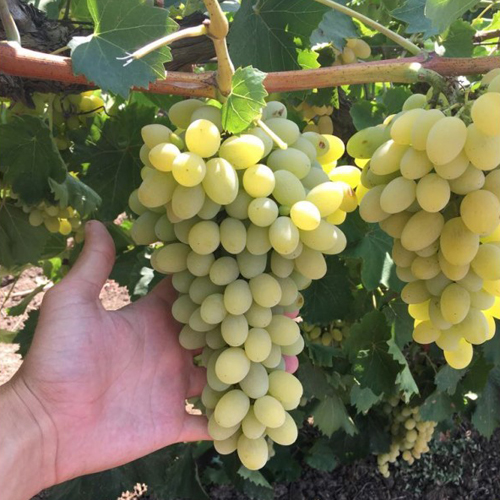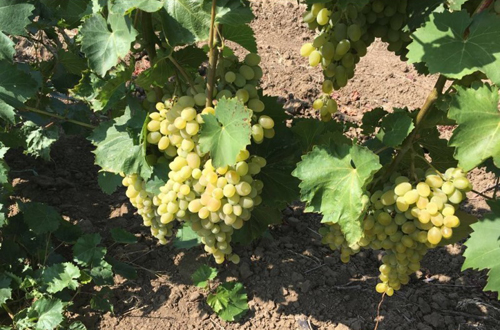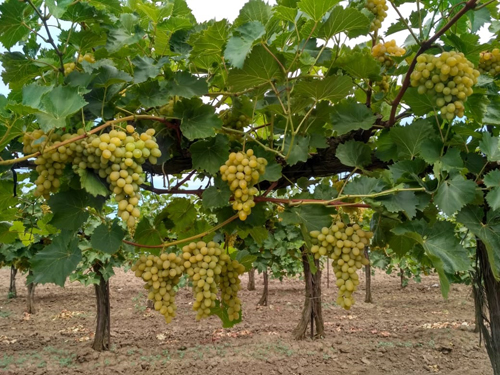Grape variety Augustine (Phenomenon)
Augustine is a wonderful in all respects table grape variety of Bulgarian selection, which has a whole set of positive qualities and, in fact, is devoid of major shortcomings. It was introduced at the Research Institute of Plant Protection in the Bulgarian city of Pleven, and since 2002 has been officially included in the State Register of Breeding Achievements Admitted to Use in the Russian Federation. Zoned in the North Caucasian region of the Russian Federation (Stavropol and Krasnodar Territories, the Republic of Crimea, Adygea, North Ossetia-Alania, Dagestan, Ingushetia, Chechen, Kabardino-Balkarian, Rostov regions). Currently, it is actively cultivated in industrial plantings of the Rostov Region and Krasnodar Territory, and is also very popular among amateur winegrowers throughout the country.

Augustine was obtained from a cross between the popular local Pleven and the very stable French so-called “direct breeder hybrid” Villard blanc. The latter is a complex interspecific hybrid, whose DNA contains 56.19% of the genes of the European cultivated grape vitis vinifera and the "explosive mixture" of genes of American species: 29.16% vitis rupestris, 6.25% vitis berlandieri, 5.28% vitis lincecumii and 3.13% vitis labrusca. This combination of genes of the paternal form allowed the new hybrid to acquire complex resistance to pests and diseases, while at the same time inheriting excellent aesthetic and taste qualities of the fruit from the maternal form. This hybrid was named Augustine, although, keeping in mind the parents, many often call it Pleven stable, the name Phenomenon is also known.
In addition to its high resistance to diseases, the variety is very fond of for its regular abundant fruiting, good winter hardiness, general unpretentiousness to growing conditions, and, of course, high tasting ratings of grapes, which also have an excellent presentation, good transportability and the ability to survive both on bushes and assembled.
Agrobiological characteristics
Bushes are powerful, vigorous, fast-growing. The leaves are large, rounded with a slightly elongated middle lobe, slightly dissected, five-lobed. The lateral notches are barely marked or quite shallow. The upper side of the leaf blade is dark green, shiny and smooth, as a rule flat, but there are also weakly curved to the top. Below the leaf is covered with sparse cobweb pubescence, with bristles along the veins. The petiole notch is open, narrow, vaulted, with a flat bottom. Augustine's flowers are bisexual; there are no problems with pollination under normal weather conditions.

Bunches of grapes are large, up to 20 cm long and up to 15 cm wide, with an average weight of 400-800 grams. Conical in shape, moderately dense. The comb is of medium length, the stems of the berries are short and strong. The berries themselves are large (on average 27 × 18 mm), weighing 5-7 grams, oval or elongated-oval, white, and amber-yellow in the sun. Covered with a thin layer of pruin plaque. Particularly attractive to the bunches is the light translucence of the berries in the light. In the rays of the sun, they seem to glow from the inside. The pulp is dense, juicy-fleshy, with a simple but very harmonious taste. Medium skin, edible. Large seeds in berries spoil the overall picture somewhat, but the overall tasting score, despite this annoying fact, remains high.
Bunches can persist on the bushes for a long time after ripening, however, it must be borne in mind that the variety is susceptible to the attack of the grape leafworm, and therefore measures are required to protect against this pest. Wasps, on the other hand, practically do not damage grapes. In addition, it is worth keeping in mind the possibility of cracking of Augustine berries with excessive soil moisture or its sharp drops, which makes it undesirable for a ripe crop to stay on the vine for a long time in unfavorable weather conditions.It is better in such cases to store it already assembled in cool dry places.
The crop is intended mainly for fresh consumption, but at the same time excellent juices, compotes, and preserves are obtained from it. Due to the large, pleasant in appearance, literally "liquid" berries, the harvest of this variety is of interest and demand in the market, has excellent transportability and is quite well stored, provided that it is timely, accurate collection and there is no damage by pests. Only when transporting overripe bunches of grapes over long distances is a slight shedding of berries possible.

The variety is early maturing. For the ripening of the crop, 115-120 days of vegetation are required and a total of 2400-2500 ° C of active temperatures. Thanks to this, it manages to ripen even in the Ryazan and Kaluga regions, not to mention the more southern territories. Augustine's frost resistance is increased (-24 ° C), but in relatively northern regions it will still have to be grown in a covering culture. The yield is very high, during the state variety test, the Phenomenon showed results up to 184 c / ha, or an average of 8-10 kilograms of grapes per bush. Individual plants also showed much better performance. The percentage of fruitful shoots in the hybrid is high - up to 85%, while the number of clusters per fruitful shoot is average (0.8-1.2). The sugar content of berry juice in the course of variety testing in different years was in the range from 17.1 to 17.5 g / 100 ml, titratable acidity - 6.5-9.4 g / dm3. The average score of tasting assessments of fresh berries over a five-year period is 8.2.
Agrotechnical features
In terms of the sum of its agrobiological properties, Augustine can be ranked among the most unpretentious varieties, among fruits comparable in quality and taste characteristics. It can rightfully be called a complex-resistant grape variety, which allows it to be grown with a minimum pesticide load, and ultimately get a crop clean from all sorts of "chemistry". So, against the main fungal diseases, protection can be reduced to single preventive spraying during periods of the greatest harmfulness of pathogens. The only ones against whom it will be necessary to wage a serious fight are the bunchworms. Given the greatest harmfulness of their first generation, it is necessary to carry out a mandatory treatment with an insecticide before flowering. The second and third generations cause less harm, but for the greatest confidence in the complete destruction of the pest, you can carry out another 1-2 spraying during the growth of the berries, with the obligatory observance of the instructions and waiting periods specific to each specific drug.
Augustine lacks resistance to phylloxera, and therefore its planting in zones of infection with this pest is possible only with grafted seedlings. Fusion of the variety with common rootstocks is high, as well as the rooting rate of its own cuttings. But, unfortunately, the reproduction of the Phenomenon in a rooted culture can only be used where phylloxera has not yet reached.
After planting, the grapes grow rapidly and begin to bear fruit. Prefers large high-stemmed formations, grows well and gives very high yields in arched and arbor cultures. However, in regions with relatively cold winters, all these preferences are limited to the insufficiently high frost resistance of the vines for these places. Here it is necessary to form much more compact bushes, adapted for shelter for the winter. A moderate load on the bush is usually recommended - 35-45 eyes, but here everything is very individual, and depends on many factors - the age of the plant, the method of formation, the volume of accumulated perennial wood, the adequacy of nutrition, the moisture supply of the plant and many others.Therefore, the choice of the optimal load for each specific case still remains with the grower.
Augustine is less prone to overloading the harvest than other table varieties, however, he also needs to pay attention to this circumstance, especially if you are worried that during the spring pruning you overestimated the strength of the bush. In this case, it is quite possible to correct shortcomings in determining the load during green operations with vegetative plants. Be sure to remove weak and barren shoots on the bushes so as not to distract food from the fruitful vines. Also thin out the bunches on those shoots that, in your opinion, will not "stretch" them all. At the same time, do not be afraid to experiment, because Augustine is one of those few highly productive, but very plastic varieties that forgive the winegrower for his non-critical mistakes. Including for this it is appreciated and loved by many admirers in all those countries where this truly magnificent grape is grown.









I got used to calling this variety Pleven improved, my favorite grape. We have been growing it for over 10 years. Delicious, dense berries. Ripens early. We have it around the middle of August, so they bring him to Yablochny with other fruits to bless him. If you leave it on the bush longer, it tastes even better. True, wasps do damage. Last year the last brush was removed in October. The bunches are rarely small, usually weighing more than 500 - 600 g. During all the years of cultivation, it froze a little in winter only a couple of times. Most disease resistant. We hardly treat with chemicals, unlike other varieties.